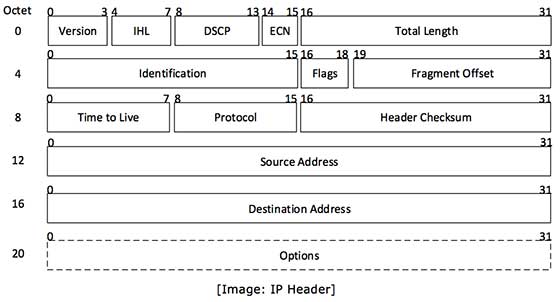Below a visual description of the Header options found within an IPv4 packet:

Here is a description of every option field within the IP header:
Version: Version number of Internet Protocol used. For IPv6 Packet this field will be set to 6.
IHL: Internet Header Length(4 bits field), this value tells how big the packet is. The minimum value allowed is 5 which would be 20 bytes (no options). The maximum value possible is 15, for a packet header length of 60 bytes (allowing a maximum of 40 bytes for "options").
DSCP: Differentiated Services Code Point, this is where you can apply your QoS tags.
ECN: Explicit Congestion Notification, carries information about the congestion seen in the route.
Total Length: Length of entire IP Packet (including IP header and IP Payload). This field (16 bits) contains the total length of the packet, including the packet header, in bytes. The minimum length is 20 (20 bytes of header plus 0 bytes of data), and the maximum is 65,535 bytes (since only 16 bits are available to specify this). All network links must be able to handle packets of at least 576 bytes, but a more typical packet size is 1508 bytes.
Identification: If IP packet is fragmented during the transmission, all the fragments contain same identification number to identify original IP packet they belong to.
Flags: As required by the network resources, if IP Packet is too large to handle these ‘flags’ tell that if they can be fragmented or not. In this 3-bit flag, the MSB is always set to ‘0’.
The next three bits are flags related to fragmentation:
The second bit is the DF (Don’t Fragment) flag. If DF is set, the packet cannot be fragmented.
If a packet with DF set reaches a gateway where the ongoing path can’t handle that fragment size without fragementing it, that packet is dropped (and non-delivery notification is returned to the sender).
The third bit is the MF (More Fragments) flag. If MF is set, there are more fragments to come. Unfragmented packets have the MF flag set to zero.
Fragment Offset: This offset field (13 bits) tells the exact position of the fragment in the original IP Packet. It is used in reassembly of fragmented packets. It is measured in 8 byte blocks. The first fragment of a set has an offset of 0. Re-assembly involves putting the fragments together in a buffer, with each new fragment located in the reassembly buffer starting at Fragment Offset * 8 bytes from the beginning of the buffer.
Time to Live: (8 bits field)To avoid looping in the network, every packet is sent with a TTL value set, which tells the network how many hops this packet can cross. At each hop, its value is decremented by one and when the value reaches zero, the packet is discarded. The default TTL value is 64, packets with TTL set to 1 within a network segment are meant to be processed by local router.
Protocol: Tells the Network layer at the destination host, to which Protocol this packet belongs to. For example protocol number of ICMP is 1, TCP is 6 and UDP is 17.
Header Checksum: This field is used to keep checksum value of entire header which is then used to check if the packet is received error-free.
Source Address: 32-bit address of the Sender of the packet.
Destination Address: 32-bit address of the Receiver of the packet.
Options: (o - to 40 Bytes field) This is optional field, which is used if the value of IHL is greater than 5. These options may contain values for options such as Security, Record Route, Time Stamp etc.
No comments:
Post a Comment